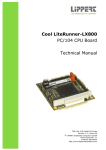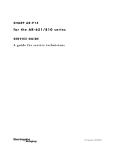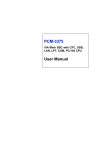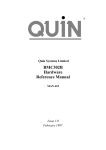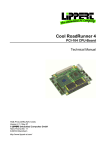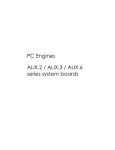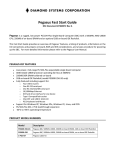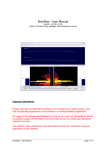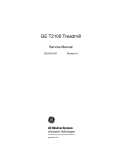Download Data Modul AG ENX-LX800 Specifications
Transcript
Cool SpaceRunner-LX800 PC/104-Plus CPU Board Technical Manual TME-104P-CSR-LX800-R1V11.doc Revision 1.11 / April 11 ©LiPPERT Embedded Computers GmbH Hans-Thoma-Str. 11 D-68163 Mannheim http://www.lippertembedded.com/ Technical Manual Cool SpaceRunner-LX800 LiPPERT Document: TME-104P-CSR-LX800-R1V11 Revision 1.11 Copyright ©2011 LiPPERT Embedded Computers GmbH, All rights reserved Contents and specifications within this manual are subject of change without notice. Trademarks MS-DOS, Windows, Windows 95, Windows 98, Windows NT and Windows XP are trademarks of Microsoft Corporation. PS/2 is a trademark of International Business Machines, Inc. Intel and Solid State Drive are trademarks of Intel Corporation. Geode is a trademark of Advanced Micro Devices. PC/104 is a registered trademark of PC/104 Consortium. All other trademarks appearing in this document are the property of their respective owners. Disclaimer Contents and specifications within this technical manual are subject of change without notice. LiPPERT Embedded Computers GmbH provides no warranty with regard to this technical manual or any other information contained herein and hereby expressly disclaims any implied warranties of merchantability or fitness for any particular purpose with regard to any of the foregoing. LiPPERT Embedded Computers GmbH assumes no liability for any damages incurred directly or indirectly from any technical or typographical errors or omissions contained herein or for discrepancies between the product and the technical manual. In no event shall LiPPERT Embedded Computers GmbH be liable for any incidental, consequential, special, or exemplary damages, whether based on tort, contract or otherwise, arising out of or in connection with this user’s guide or any other information contained herein or the use thereof. Table of Contents 1 1.1 1 Overview Introduction ............................................................................................... 1 Features .................................................................................................... 1 Block Diagram ............................................................................................. 2 1.2 Ordering Information .................................................................................... 3 Cool SpaceRunner-LX800 Models ..................................................................... 3 Cable Sets and Accessories ............................................................................ 3 1.3 Specifications............................................................................................. 4 Electrical Specifications ................................................................................. 4 Environmental Specifications ........................................................................... 4 Mean Time Between Failures ........................................................................... 4 1.4 2 2.1 Mechanical ................................................................................................ 5 6 Getting Started Connector Locations .................................................................................... 6 Top .......................................................................................................... 6 Bottom ...................................................................................................... 7 2.2 Jumper Locations ........................................................................................ 8 2.3 LED indicators ............................................................................................ 9 2.4 Hardware Setup ........................................................................................ 10 3 11 Module Description 3.1 Processor ............................................................................................... 11 3.2 Companion .............................................................................................. 12 3.3 Graphics-Controller.................................................................................... 13 VGA Connector ........................................................................................... 14 LVDS Configuration...................................................................................... 15 LVDS Connector ......................................................................................... 15 LVDS Color Mapping .................................................................................... 16 Backlight Connector ..................................................................................... 16 Display Voltage Jumpers ............................................................................... 17 3.4 EIDE Solid State Drive ................................................................................ 17 TME-104P-CSR-LX800-R1V11.doc Rev 1.11 i 3.5 Ethernet Controller ..................................................................................... 18 Ethernet Interface ........................................................................................ 18 3.6 On Board Power Supply .............................................................................. 19 Power Connector ........................................................................................ 19 3.7 EIDE Port ................................................................................................ 20 EIDE Connector .......................................................................................... 20 3.8 PS/2 Interface .......................................................................................... 21 Keyboard and Mouse Connector ..................................................................... 21 3.9 USB 2.0 Ports .......................................................................................... 21 USB 2.0 Connector 0.................................................................................... 22 USB 2.0 Connector 1/2/3 ............................................................................... 22 3.10 Serial Ports .............................................................................................. 23 COM1/2 Connector ...................................................................................... 23 RS485-Termination Jumpers .......................................................................... 24 3.11 Parallel Port LPT ....................................................................................... 24 LPT Connector ........................................................................................... 25 3.12 Speaker .................................................................................................. 26 3.13 External Power-Button ................................................................................ 26 3.14 Reset-In Signal ......................................................................................... 27 3.15 Internal Battery ......................................................................................... 27 3.16 External Battery ........................................................................................ 27 3.17 PC/104-Plus Bus Interface ........................................................................... 28 PC/104 Plus Bus Connector ........................................................................... 29 3.18 PC/104 Bus Interface ................................................................................. 30 PC/104 Bus Connector ................................................................................. 30 3.19 4 BIOS Recovery ......................................................................................... 31 32 Using the Module 4.1 Watchdog ............................................................................................... 32 4.2 LEMT functions ......................................................................................... 32 4.3 BIOS...................................................................................................... 33 Battery Jumper ........................................................................................... 33 Configuring the XpressROM BIOS .................................................................... 33 TME-104P-CSR-LX800-R1V11.doc Rev 1.11 ii Trouble Shooting BIOS Settings ...................................................................... 41 4.4 Drivers ................................................................................................... 42 4.5 Programming Examples .............................................................................. 43 LIVE-LED .................................................................................................. 43 Watchdog ................................................................................................. 44 Reading Temperatures .................................................................................. 45 Reading Voltages ........................................................................................ 46 5 47 Address Maps 5.1 Memory Address Map ................................................................................ 47 5.2 I/O Address Map ....................................................................................... 48 5.3 Interrupts ................................................................................................ 49 5.4 DMA Channels.......................................................................................... 49 5.5 PC/104 Bus Address Space ......................................................................... 50 Appendix A, Contact Information A Appendix B, Additional Information B Appendix C, Getting Help C Appendix D, Revision History D TME-104P-CSR-LX800-R1V11.doc Rev 1.11 iii Acronyms ACPI AES APM ATA BIOS BPP CD COM CPU CRT CSR DAC DDR DMA DOT EIDE EMC ETH FIFO FPU FWH GPIO HDD I²C IP ISA LCD LEMT LED LPC LVDS MAC MMU PCI PHY PLL PS/2 PWR SMB SMC SPI SSD SVGA TCP TLB UART USB UDMA UDP VGA WDOG Advanced Configuration and Power Management Interface Advanced Encryption Standard Advanced Power Management Advanced Technology Attachment Basic Input Output System Bits Per Pixel Compact Disc Communication Equipment Central Processing Unit Cathode Ray Tube Cool SpaceRunner Digital-to-Analog-Converter Double Date Rate Direct Memory Access Dynamic Overclocking Technology Enhanced Integrated Device Electronics Electromagnetic Compatibility Ethernet First In First Out Floating Point Unit Firmware Hub General Purpose Input Output Hard Disk Drive Inter-Integrated Circuit Internet Protocol Industry Standard Architecture Liquid Crystal Display LiPPERT Enhanced Management Technology Light Emitting Diode Low Pin Count Low Voltage Differential Signaling Media Access Control Memory Management Unit Peripheral Component Interconnect Physical Interface Phase-Locked Loop Personal System/2 Power System Management Bus System Management Controller Serial Peripheral Interface Solid State Drive Super Video Graphics Array Transmission Control Protocol Translation Look-aside Buffer Universal Asynchronous Receiver Transmitter Universal Serial Bus Ultra-Direct Memory Access User Datagram Protocol Video Graphics Array Watchdog TME-104P-CSR-LX800-R1V11.doc Rev 1.11 iv 1 Overview 1.1 Introduction The Cool SpaceRunner-LX800 is a CPU-board for especially designed with rugged appliances in mind. It allows the design of devices without moving parts. Additional resilience comes from the used through-hole connectors. The PC/104-Plus board with AMD’s Geode™ LX processor has a very good performance to power ratio. The board comprises all peripherals needed for an embedded PC on a small 3.775" by 4.050" printed circuit board. It is fully plug-in compatible with the Cool SpaceRunner 2, except that the Flat Panel connector is replaced with three USB 2.0 ports. The Cool SpaceRunner-LX800 integrates a powerful yet efficient AMD Geode™ LX800 processor together with a CS5536 I/O companion and a Super I/O chip to form a complete PC, with all the standard peripherals already onboard. There is a graphics controller with VGA and LVDS adapters to connect different sorts of display terminals. Backlighting is provided for LCD modules too. A fast 100/10BaseT Ethernet port, two RS232/RS422/RS485 serial ports, and four USB 2.0 host ports handle the communication with external devices. There are PS/2 connectors for keyboard and mouse as well as a parallel printer port available. An IDE ATA100 adapter allows connection of hard disk or CD drives. Applications that require non-moving storage can use the integrated Solid State Drive. There is Solid State Drive (SSD) integrated, which is connected to the ATA-controller. System expansion can easily be realized over PC/104, PC/104-Plus and I²C bus connectors. The Cool SpaceRunner-LX800 is powered by a 5V-only supply and supports ACPI, advanced power management and PCI power management. Security critical applications take advantage of the Geode LX800 processor, too. It has an on-chip AES 128-bit crypto acceleration block capable of 44 Mbps throughput on either encryption or decryption. The AES block runs asynchronously to the processor core and is DMA based. The Cool SpaceRunner-LX800 runs DOS, Windows, Linux and VxWorks operating systems. Features CPU Main Memory · · · · · · · soldered 256 MB DDR SDRAM 400 MHz AMD Geode™ LX 800@0,9W (500MHz) Cache Memory with: 64 KB/64 KB level 1 I/D caches TLB (Translation Look-aside Buffer): 128 KB level 2 cache Efficient Prefetch Chipset Extension slots · AMD CS5536 companion device · 1 x 32-bit PC/104-Plus · 1 x 16-bit PC/104 with full DMA capability Interfaces · · · · · · Ethernet 10/100BaseT ATA-6 EIDE (Ultra DMA-100) PS/2 Keyboard/Mouse 4 x USB 2.0 ports 2 x RS232/RS485/RS422, software selectable 1 x parallel port · SVGA monitor · 18/24 Bit LVDS for displays · MISC signals: external power button, I²C bus, speaker, external reset button, external battery connector · Power supply · Solid Sate Drive on EIDE Other configurations are possible at high volumes. TME-104P-CSR-LX800-R1V11.doc Rev 1.11 1 (50) Block Diagram COM1 RS232/485 IDC 10 2.54 mm LPT/ Parallel IDC 26 2.54 mm Line Driver LTC1334 Super I/O ITE8712 COM2 RS232/485 IDC 10 2.54 mm Line Driver LTC1334 PS/2-MS/KB MISC IDC 10 2.54 mm PS/2 SMC UPD78F0511GA LPC FWH DF13 10 pin 1.25 mm SST FWH SST25LF080A SPI SMB EIDE IDC 44 2.00 mm EIDE SSD 2GB USB1/2/3 IDC12 2.54 mm I/O Companion CS5536 USB0 Ethernet1 IDC 10 2.54 mm ETH Intel 82551IT PCI PCI -> ISA ITE8888 VGA IDC 10 2.54 mm ISA PCI PC/104 Plus Backlight DF13 8 pin 1.25 mm AMD Geode LX800 LVDS DF14 2 x 10 pin 1.25 mm Transmitter DS90C383B PC/104 Memory 256 MB CSR-LX800 PC/104- Diagram rev1v2 10072008CS TME-104P-CSR-LX800-R1V11.doc Rev 1.11 2 (50) 1.2 Ordering Information Cool SpaceRunner-LX800 Models Order number Description 903-0019-10 Cool SpaceRunner-LX800 with LCD+VGA-CRT, AMD GEODE [email protected] (500 MHz), low power consumption, 256MB DDR SDRAM, 4x USB2.0, IrDA, RTC, Battery, EIDE, 3x COM, LPT (EPP/EPC), PS/2 Keyboard, PS/2 Mouse, WDOG, LEMT, PC/104 bus, PC/104+ bus, VGA controller and LVDS Interface, Fast Ethernet 100/10BaseT, EIDE 2 GB SSD Operating temperature range: -40°C…+85°C Cable Sets and Accessories There are some options offered for the Cool SpaceRunner-LX800. Order number Description 863-0014-10 Adapter Cable Set Power, PS/2 keyboard and mouse, Ethernet and USB, VGA-CRT, 3x USB, COM1, COM2, LPT, IDE (44 pin, 2mm), cable adapter 2.5" > 3.5", adapter 3.5" > 2.5" TME-104P-CSR-LX800-R1V11.doc Rev 1.11 3 (50) 1.3 Specifications Electrical Specifications Supply voltage +5 V DC Rise time < 10 ms Supply voltage tolerance ± 5% Inrush current 6.5 A, 25µs Supply current maximal 0.95 A (Memtest86 v1.70) typical 0.6 A (Windows XP idle mode) typical 0.2 A (suspend to ram mode) 1 2 Environmental Specifications Operating: Temperature range -20 … 60 °C (standard version) -40 … 85 °C (extended version) Temperature change max. 10K / 30 minutes Humidity (relative) 10 … 90 % (non-condensing) Pressure 450 … 1100 hPa Non-Operating/Storage/Transport: Temperature range -40 … 85 °C Temperature change max. 10K / 30 minutes Humidity (relative) 5 … 95 % (non-condensing) Pressure 450 … 1100 hPa Mean Time Between Failures MTBF at 25°C 1 294 173 hours With that tolerance is not mentioned that all plugged devices are running with. 2 That rate of current is possible when only monitor, mouse and keyboard are plugged. If there are connected additional peripheral devises the current rises up. TME-104P-CSR-LX800-R1V11.doc Rev 1.11 4 (50) 1.4 Mechanical Dimensions (L x W) 95.9 mm x 90.2 mm (including I/O extension) Height max. 14 mm on top side above PCB max. 12 mm on bottom side above PCB Weight 100 g Mounting 4 mounting holes Note: It is strongly recommend using plastic spacers instead of metal spacers to mount the board. With metal spacers, there is a possible danger to create a short circuit with the components located around the mounting holes. This can damage the board! TOP Pin1 TME-104P-CSR-LX800-R1V11.doc Pin2 Rev 1.11 5 (50) 2 Getting Started 2.1 Connector Locations Top (Click on the blue font to reach the right chapter.) LPT X15 COM1 X11 COM2 X12 PC/104 Plus X17 PC/104 X18 PWR X19 LVDS X7 Backlight X6 ETH/USB0 X9 USB1/2/3 X8 VGA X3 EIDE X10 PS/2 X16 The connectors' pin 1 is marked RED TME-104P-CSR-LX800-R1V11.doc Rev 1.11 6 (50) Bottom PC/104 Plus X17 PC/104 X18 The connectors' pin 1 is marked RED TME-104P-CSR-LX800-R1V11.doc Rev 1.11 7 (50) 2.2 Jumper Locations (Click on the blue font to reach the right chapter.) Jumper COM1 termination X13 Pin 1 Pin 3 Pin 2 Pin 4 Jumper COM2 termination X14 Pin 1 Pin 3 Pin 2 Pin 4 Jumper Battery X30 Jumper LVDS and Backlight Power Supply X5 TME-104P-CSR-LX800-R1V11.doc Rev 1.11 8 (50) 2.3 LED indicators The onboard LED indicators provide a very comfortable way to check the board’s status. The boot success, power status, IDE accesses, Watchdog and Ethernet accesses are all visible. The LED indicators are located on top of the board, near the PC/104 connector. LINK Green LED shows the Ethernet Link status. ACT Red LED flashes at Ethernet activity. Speed Yellow LED lights up if 100Mbit connection is established. MAIN Green LED lights up when Main Power is supplied. PM Power Mode Green LED is constantly lit if the boot process is complete and the board is running normally. LED flashes when board goes in suspend to ram mode. SBY Green LED lights up when Standby Power is supplied. LIVE Red LED is on at startup while the board executes the BIOS power on self test (POST). After that it is freely usable by application programs. Chapter "LIVE-LED" shows a small sample program how to control it. IDE Yellow LED flashes when IDE activity is recognized. WD Red LED lights up when Watchdog was triggered. Can only be reset by a power off sequence. TME-104P-CSR-LX800-R1V11.doc Rev 1.11 9 (50) 2.4 Hardware Setup Caution Be sure to observe the EMC security measures. Make sure you are always at the same potential as the module. Caution Never connect or disconnect peripherals like HDD's, PCI, and ISA boards while the board's power supply is connected and switched on! Use the cable set provided by LiPPERT to connect the Cool SpaceRunner-LX800 to a VGA monitor. Connect either PS/2 or USB keyboard or mouse, respectively. Use the 44-wire cable to connect the hard disk. Make sure that the pins match their counterparts correctly and are not twisted! If you plan to use additional other peripherals, now is the time to connect them, too. Set the “Jumper Battery” that it has contact with both pins. The location can be found on chapter 2.2. Connect a 5 volt power supply to the power connector and switch the power on. Note In continuous mode there only about 1 amp necessary, but at power on there are more than 6,5 A inrush current required. The display shows the BIOS messages. If you want to change the standard BIOS settings, press the <F1> key to enter the BIOS menu. See chapter 4.3 for setup details. If you need to load the BIOS default values, they can be automatically loaded at boot time. See chapter "Trouble Shooting BIOS Settings", about how to do it. The Cool SpaceRunner-LX800 boots from CD drives, USB floppy, USB stick, or hard disk. Provided that any of these is connected and contains a valid operating system image, the display then shows the boot screen of your operating system. The Cool SpaceRunner-LX800 does not need any cooling measures, neither at standard environment temperatures from –20 °C … +60 °C nor in the extended range of -40 °C ... +85 °C. TME-104P-CSR-LX800-R1V11.doc Rev 1.11 10 (50) 3 Module Description 3.1 Processor The AMD Geode LX [email protected] processor delivers one of the best performance-per-watt figures in the industry, providing x86 power and versatility to embedded products. Its architecture and high level of integration guarantees longer battery life and allows very small designs, while delivering full x86 functionality. The AMD Geode LX 800 processor consumes a maximum power of 3.9W and 1.8W typical at 500 MHz, enabling systems that only need to be passively cooled. The x86 compatibility allow designers to focus on developing end products that efficiently meet consumer needs without being concerned with software porting or compatibility issues. Coupled with the AMD Geode™ CS5536 companion device, the combined chipset, which operates at 1.9W typical at 433MHz and at 2.4W typical at 500MHz, offers a complete set of features that deliver full desktop functionality to embedded and portable devices. Internal block diagram of the LX 800 processor TME-104P-CSR-LX800-R1V11.doc Rev 1.11 11 (50) Processor functional blocks are · CPU Core · GeodeLink™ Control Processor · GeodeLink Interface Units · GeodeLink Memory Controller · Graphics Processor · Display Controller · Video Processor · Video Input Port · GeodeLink PCI Bridge · Security Block For further information please refer to the data book of the AMD Geode LX 800 TM P 3.2 P P Companion AMD Geode™ CS5536 companion device The AMD Geode™ CS5536 companion device is designed to work with an integrated processor North Bridge component such as the AMD Geode™ GX/LX processor. Together, the Geode GX/LX processor and Geode CS5536 companion device provide a system-level solution well suited for the high-performance and low-power needs of a host of embedded devices including digital set-top boxes, mobile computing devices, thin client applications, and single board computers. The internal architecture uses a single, high-performance modular structure based on GeodeLink™ architecture. This architecture yields high internal speed (over 4 GB/s) data movement and extremely versatile internal power management. The GeodeLink™ architecture is transparent to application software. Communication with the Geode GX/LX processor is over a 33/66 MHz PCI bus. The Geode CS5536 companion device incorporates many I/O functions, including some found in typical Super-I/O chips, simplifying many system designs. Since the graphics subsystem is entirely contained in the Geode GX/LX processor, system interconnect is simplified. The device contains state-of-the-art power management that enables systems, especially battery powered systems, to significantly reduce power consumption. Audio is supported by an internal controller, designed to connect to multiple AC97 compatible codecs. An IR (infrared) port supports all popular IR communication protocols. The IR port is shared with one of two industrystandard serial ports that can reach speeds of 115.2 kbps. An LPC (low pin count) port is provided to facilitate connections to a Super-I/O should additional expansion, such as a floppy drive, be necessary, and/or to an LPC ROM for the system BIOS The hard disk controller is compatible to the ATA-5 specification. The bus mastering IDE controller includes support for two ATA-compliant devices on one channel. The CS5536 companion device provides four Universal Serial Bus (USB) 2.0 compliant ports, supporting low speed, full speed, and high speed connections. All four ports are individually automatically associated with either the Open Host Controller Interface (OHCI) or the Enhanced Host Controller Interface (EHCI) depending on the attached device type. A real-time clock (RTC) keeps track of time and provides calendar functions. A suite of 82xx devices provides the legacy PC functionality required by most designs, including two PIC's (programmable interrupt controllers), one PIT (programmable interval timer) with three channels, and DMA (direct memory access) functions. The CS5536 companion device contains eight MFGPT's (multi-function general purpose timers) that can be used for a variety of functions. A number of GPIO's (general purpose input/outputs) are provided, and are assigned to system functions on power-up. State-of-the-art power management features are attained with the division of the device into two internal power domains. The GPIO's and multi-function timers are distributed into each domain allowing them to act as wakeup sources for the device. The device provides full ACPI (Advanced Configuration Power Interface) compliance and supports industry-standard Wakeup and Sleep modes. TME-104P-CSR-LX800-R1V11.doc Rev 1.11 12 (50) 3.3 Graphics-Controller The graphics controller is integrated in the Geode LX processor and does high performance 2D-graphics handling. CRT monitors can be used as well as LVDS displays. Therefore, two different connectors are on the board. It is possible to use a CRT and a LVDS display simultaneously (depends on drivers setting), but only with the same graphics content on both displays. The Cool SpaceRunner-LX800 supports 3,3V and 5V LVDS displays with 18/24bit interfaces and unconventional signal configuration. The display type and resolution can be selected in BIOS setup: Graphics Configuration SVGA Configuration Resolution Color Depth (bpp) Refresh Rate (Hz) Dot Clock (MHz) Min. GLIU Frequency (MHz) 640 x 480 8, 16, or 24/32 60 25.175 75 8, 16, or 24/32 70 28.560 75 8, 16, or 24/32 72 31.500 75 8, 16, or 24/32 75 31.500 75 8, 16, or 24/32 85 36.000 75 8, 16, or 24/32 90 37.889 400 8, 16, or 24/32 100 43.163 400 8, 16, or 24/32 60 40.000 75 8, 16, or 24/32 70 45.720 75 8, 16, or 24/32 72 49.500 75 8, 16, or 24/32 75 49.500 75 8, 16, or 24/32 85 56.250 75 800 x 600 1024 x 768 1152x864 1280 x 1024 8, 16, or 24/32 90 60.065 400 8, 16, or 24/32 100 68.179 400 8, 16 or 24/32 60 65.000 75 8, 16, or 24/32 70 75.000 100 8, 16, or 24/32 72 78.750 100 8, 16, or 24/32 75 78.750 100 8, 16, or 24/32 85 94.500 100 8, 16, or 24/32 90 100.187 400 8, 16, or 24/32 100 113.310 400 8, 16, or 24/32 60 81.600 100 8, 16, or 24/32 70 97.520 100 8, 16, or 24/32 72 101.420 200 8, 16, or 24/32 75 108.000 200 8, 16, or 24/32 85 119.650 200 8, 16, or 24/32 90 129.600 400 8, 16, or 24/32 100 144.000 400 8, 16, or 24/32 60 108.000 200 8, 16, or 24/32 70 129.600 200 8, 16, or 24/32 72 133.500 200 8, 16, or 24/32 75 135.000 200 TME-104P-CSR-LX800-R1V11.doc Rev 1.11 13 (50) Resolution Color Depth (bpp) Refresh Rate (Hz) Dot Clock (MHz) Min. GLIU Frequency (MHz) 8, 16, or 24/32 85 157.500 200 1600 x 1200 1920x1440 8, 16, or 24/32 90 172.800 400 8, 16, or 24/32 100 192.000 400 8, 16, or 24/32 60 162.000 200 8, 16, or 24/32 70 189.000 200 8, 16, or 24/32 72 198.000 233 8, 16, or 24/32 75 202.500 233 8, 16, or 24/32 85 229.500 266 8, 16, or 24/32 90 251.182 400 8, 16, or 24/32 100 280.640 400 8, 16, or 24/32 60 234.000 266 8, 16, or 24/32 70 278.400 400 8, 16, or 24/32 72 288.000 400 8, 16, or 24/32 75 297.000 400 8, 16, or 24/32 85 341.349 400 VGA Connector Connector type: Matching connector: IDC10 pin header 2.54 mm IDC10 pin female connector 2.54 mm Pin Signal Pin Signal 1 Red 2 GND 3 Green 4 GND 5 Blue 6 GND 7 HSYNC 8 GND VSYNC 10 GND 9 X3 TME-104P-CSR-LX800-R1V11.doc Rev 1.11 14 (50) LVDS Configuration The display options of LVDS are shown in the table: Setting Possible Values Flat Panel Type Resolution LVDS 320x240, 640x480, 800x600, 1024x768, 1152x864, 1280x1024, 1600x1200 Data Bus Type 18/24 Bits, 2ppc Refresh Rate 60 70, 72, 75, 85, 90, 100 Hz HSYNC Polarity High, Low VSYNC Polarity High, Low LP Active Period Active Only Free Running à only active during SYNC à always active SHFCLK Active Period Active Only Free Running à only active during SYNC à always active To ease usage of these displays it’s possible to select the display and backlight supply voltages with the onboard voltage selector jumpers. (Jumper LVDS and Backlight, see below) LVDS Connector Connector type: Matching connector: Pin Signal 2 SW-VDD 4 6 8 3 Hirose DF13 2x 10-pin header Hirose DF13-20DS-1.25C, part number 536-0555-6 00 Pin Signal 1 SW-VDD GND 3 GND TX3+ 5 TX3GND 3 3 TXCLK- 7 10 GND 9 TXCLK+ 12 TX2+ 11 TX2- 14 TX1- 13 GND 16 GND 15 TX1+ 18 TX0+ 17 TX0- 20 DDC DATA 19 DDC CLK X7 1.0 A is the maximum current for each pin TME-104P-CSR-LX800-R1V11.doc Rev 1.11 15 (50) LVDS Color Mapping Backlight Connector Connector type: Matching connector: Hirose DF13 8 pin Hirose DF13-8S-1.25C, part number 536-0007-0 00 Pin Signal 1 +12 Volt 4 2 +12 Volt 4 3 +5 Volt 4 4 +5 Volt 4 5 EN 6 VCC 7 GND 8 GND 5 4 0.5 A is the maximum current for each pin 5 That voltage can be selected using the jumper "Backlight", shown on next page. TME-104P-CSR-LX800-R1V11.doc Rev 1.11 X6 16 (50) Display Voltage Jumpers Jumper LVDS and Backlight Connector type: Matching part: IDC6 pin header 2.0 mm 2.0 mm jumper Use a 2 mm jumper between 1-3 or 3-5 to select the backlight voltage. Use a 2 mm jumper between 2-4 or 4-6 to select the display voltage. Pin Signal Pin Signal 1 +12 Volt 2 +5 Volt 3 Backlight voltage 4 Display voltage 5 + 5 Volt 6 +3.3 Volt X5 default jumper setting Backlight Jumper 1-3 3-5 +12V +5V Jumper 2-4 4-6 Power supply +5V +3.3V Power supply LVDS Note: 3.4 An arrow on the PCB marks Pin 1 EIDE Solid State Drive On the top side of the board, the SSD is mounted. It can be used instead of a hard disk. Per default, it is defined as master but that can be changed in BIOS. The SSD, manufactured by SST, is built as a flash storage organized of Single Level Cells (SLC). It can be erased over 100M times without losing capacity. The wear-leveling feature can increase that number, depending on the allocation of the disk space. Product features: Read Bandwidth 30 Mbytes/s Write Bandwidth 20 Mbytes/s Access time 0.2 ms PATA Compatibility ATA-5; PIO 0-4; DMA 0-2; UDMA 0-4 Power Control Automatic power down during wait periods Automatic sleep mode during host inactivity NAND Management TME-104P-CSR-LX800-R1V11.doc Active wear-leveling algorithm Rev 1.11 17 (50) 3.5 Ethernet Controller Intel 82551IT Fast Ethernet Controller The 82551IT is an evolutionary addition to Intel’s family of 8255x controllers. It provides excellent performance by offloading TCP, UDP and IP checksums and supports TCP segmentation off-load for operations such as Large Send. The 82551IT provides an extended operating temperature in addition to all of the same capabilities and features as the 82551ER to address applications requiring a wider operating temperature range. Its optimized 32-bit interface and efficient scatter-gather bus mastering capabilities enable the 82551IT to perform high speed data transfers over the PCI bus. This capability accelerates the processing of high level commands and operations, which lowers CPU utilization. Its architecture enables data to flow efficiently from the bus interface unit to the 3 KB Transmit and Receive FIFO's, providing the perfect balance between the wire and system bus. In addition, multiple priority queues are provided to prevent data underruns and overruns. The 82551IT includes both a MAC and PHY. In also has a simple interface to the analog front end, which allows cost effective designs requiring minimal board real estate. The 82551IT is pin compatible with the 82559 family of controllers and is offered with software that provides backwards compatibility with previous 8255xER controllers. Ethernet Interface The Ethernet connector is shared with USB 0 and I²C bus. Connector type: Matching connector: IDC10 pin header 2.54 mm IDC10 pin female connector 2.54 mm Pin Signal Pin Signal 1 ETH1-TX+ 2 ETH1-TX- 3 ETH1-RX+ 4 SMB_DATA 5 SMB_CLK 6 ETH1-RX- 7 USB0+ 8 USB0- 9 VCC_USB0 10 USB-GND X9 TME-104P-CSR-LX800-R1V11.doc Rev 1.11 18 (50) 3.6 On Board Power Supply The on board power controllers generate all necessary voltages from the single supply voltage of 5 Volt. The generated 3.3 Volt is available at Backlight- and LVDS- connector. Note This 3.3 V cannot be used to supply external electronic devices with high power consumption like other PC/104 boards or displays. Power Connector Connector type: Matching connector: Note JST B15B-EH-A 15 pin JST EHR-15 15 pin female connector Pin Signal (standard) Signal (5V only) 1 +5 V +5V 2 GND GND 3 +5V +5V 4 GND GND 5 +5V +5V 6 n.c. n.c. 7 GND GND 8 GND GND 9 n.c. n.c 10 n.c. n.c 11 GND GND 12 +12V n.c 13 +12V n.c 14 GND GND 15 -12V n.c X19 The default cable adapter supports the connection of ±12V power supply. That pins are routed to the PC/104- , PC/104-plus bus as well as the backlight port. If the 5 V only power supply is required leave these pins open. The board can be supplied over the 5 V pins of the PC/104- or PC/104 plus bus too. TME-104P-CSR-LX800-R1V11.doc Rev 1.11 19 (50) 3.7 EIDE Port An EIDE port is provided by the chipset to connect one drive. The connected device can be set as master and slave, depending on the SSD mode.. To enhance the performance, this port has a 100 MB/s IDE controller in UDMA mode per the ATA-5 specification The EIDE port is available on a standard 44-pin header (2 mm) for 2.5" hard disks. Only one more EIDE device can be connected, one slot is reserved for the SSD. EIDE Connector Connector type Matching connector: IDC44 pin header 2.00 mm IDC44 pin female connector 2.00 mm Pin Signal Pin Signal 1 Reset# 2 GND 3 Data7 4 Data8 5 Data6 6 Data9 7 Data5 8 Data10 9 Data4 10 Data11 11 Data3 12 Data12 Data13 13 Data2 14 15 Data1 16 Data14 17 Data0 18 Data15 19 GND 20 NC GND 21 DRQ0 22 23 Write 24 GND 25 Read 26 GND 27 Ready 28 CSEL GND 29 DACK0 30 31 IRQ 32 IOCS16- 33 Address1 34 PD66 35 Address0 36 Address2 CS3 37 6 CS1 38 39 NC 40 GND 41 +5 Volt 42 +5 Volt 43 GND 44 GND 6 X10 6 0,8 A is the maximum current for each pin TME-104P-CSR-LX800-R1V11.doc Rev 1.11 20 (50) 3.8 PS/2 Interface PS/2-connectors for mouse and keyboard are shared with several system signals. An adapter cable for the PS/2 devices is available. Keyboard and Mouse Connector Connector type: Matching connector: 3.9 IDC10 pin header 2.54 mm IDC10 pin female connector 2.54 mm Pin Signal Pin Signal 1 Speaker 2 Mouse Clock 3 Reset-In 4 Mouse Data 5 KB Data 6 KB Clock 7 GND 8 +5 Volt Switched 9 Ext. Battery 10 Power Button 7 X16 USB 2.0 Ports Four standard USB 2.0 host ports are provided with the Cool SpaceRunner-LX800. Three are located on the IDC12 header "USB". An adapter cable is available to use standard USB devices with this connector. The other one is located on the IDC10 header "Ethernet". A standard adapter cable is available, too. It is possible to use an USB keyboard under MSDOS without special driver software. Note: 7 Not all USB keyboard models are supported. 0.5 A is the maximum current for each pin; power supply will be switched off in standby mode TME-104P-CSR-LX800-R1V11.doc Rev 1.11 21 (50) USB 2.0 Connector 0 Connector type: Matching connector: IDC10 pin header 2.54 mm IDC10 pin female connector 2.54 mm Pin Signal Pin 1 ETH1-TX+ 2 ETH1-TX- 3 ETH1-RX+ 4 SMB_DATA 5 SMB_CLK 6 ETH1-RX- 7 USB0+ 8 USB0- 9 VCC_USB0 10 USB-GND 8 Signal X9 USB 2.0 Connector 1/2/3 Connector type: Matching connector: IDC12 pin header 2.54 mm IDC12 pin female connector 2.54 mm Pin 8 Signal 1 VCC_USB1 3 USB1+ 5 VCC_USB2 7 USB2+ 9 VCC_USB3 11 USB3+ 8 8 8 Pin Signal 2 USB-GND 4 USB1- 6 USB-GND 8 USB2- 10 USB-GND 12 USB3- X8 0.5 A is the maximum current for that pin; power supply will be switched off in standby mode TME-104P-CSR-LX800-R1V11.doc Rev 1.11 22 (50) 3.10 Serial Ports The maximum supported baud rates: RS485 mode RS232 mode 1,5 Mbit/s 115 kbit/s 9 The serial ports are located on two IDC headers "COM1" and "COM2". Adapter cables with standard DSUB-9 male connectors are available. The ports either work in RS232 or RS485 mode, selectable in BIOS. When entering Serial and Parallel Device Configurations, COM Port 1 Mode and COM Port 2 Mode can be selected. Termination resistors for RS485 Mode can be set with Jumpers on pin headers as described in this chapter. To enable the transmitters of COM1 and COM2 in RS485 mode set the RTS# signal to ‘1’. Depending on your operating system driver’s logic, this may mean setting a (non-inverted) RTS bit to ‘0’ in your application software. The serial ports are programmable in BIOS setup. When entering Serial and Parallel Device Configurations, configuration of the serial ports is accessible. The following settings are possible for COM1 and COM2: · Disabled · 3F8 / IRQ4 (base address / interrupt channel) · 2F8 / IRQ3 (base address / interrupt channel) · 3E8 / IRQ4 (base address / interrupt channel) · 2E8 / IRQ3 (base address / interrupt channel) The modes can be switched between RS232 and RS485. COM1/2 Connector Connector type: Matching connector: IDC10 pin header 2.54 mm IDC10 pin female connector 2.54 mm Pin RS232 RS485 Pin RS232 RS485 1 DCD Not used 2 DSR RXD+ 3 RXD RXD- 4 RTS TXD+ 5 TXD TXD- 6 CTS Not used 7 DTR Not used 8 Not used Not used 9 GND GND 10 +5 Volt +5 Volt 10 10 X11, X12 9 10 That baud rate requires changing registers manually, it is not supported by the default driver 0.5 A is the maximum current for that pin TME-104P-CSR-LX800-R1V11.doc Rev 1.11 23 (50) RS485-Termination Jumpers Connector type: Matching connector: IDC4 pin header 2.0 mm IDC4 pin female connector 2.0 mm Use 2 mm jumpers to terminate lines correctly. There are two jumpers COM1 and COM2, respectively. The RS485 termination jumpers are located at the top of the printed circuit board, see chapter 2.2 Pin Signal Pin Signal 1 TX+ 2 TX- 3 RX+ 4 RX- X13, X14 When the jumper is set, the differential pairs are terminated with 120W between them. (e.g. RX+ and RX-) Additionally, positive/negative receive lines are pulled up/down with 1kW to 5V/GND in order to protect the transceivers of the Cool SpaceRunnerLX800 from over voltage. It is recommended to protect the ports of the external device in the same way! Caution: Termination Resistors should not be used in RS232 Mode! Otherwise, the serial ports will not work. 3.11 Parallel Port LPT The parallel port is located on an IDC26 header. An adapter cable with a standard DSUB-25 female connector is available. The parallel port is programmable in BIOS. Entering Motherboard Device Configuration à Serial and Parallel Device Configurations, configuration of LPT is accessible. LPT Parameter Base Address Mode Possible Settings Disabled, 0x378 0x3BC and 0x278 are not recommended, because of a possible conflict with the PCI to ISA Bridge Compatible, PS/2 Bi-directional, EPP 1.7, EPP 1.9 IRQ Disabled, IRQ 5, IRQ 7, IRQ 9, IRQ 10, IRQ 11 DMA None, Channel 1, Channel 3 TME-104P-CSR-LX800-R1V11.doc Rev 1.11 24 (50) LPT Connector Connector type: Matching connector: IDC26 pin header 2.54 mm IDC26 pin female connector 2.54 mm Pin Signal Pin Signal 1 Strobe 2 Auto LF 3 Data0 4 Error 5 Data1 6 Init 7 Data2 8 Select In 9 Data3 10 GND 11 Data4 12 GND 13 Data5 14 GND 15 Data6 16 GND 17 Data7 18 GND 19 ACK 20 GND 21 Busy 22 GND 23 Paper End 24 GND 25 Select 26 +5Volt 11 X15 11 0.5 A is the maximum current for that pin TME-104P-CSR-LX800-R1V11.doc Rev 1.11 25 (50) 3.12 Speaker The speaker signal is located on the IDC10 Header PS/2. A standard PC Speaker can be connected between the signal SPEAKER and VCCKB. Connector type: Matching connector: IDC10 pin header 2.54 mm IDC10 pin female connector 2.54 mm Pin Signal Pin Signal 1 Speaker 2 Mouse Clock 3 Reset-In 4 Mouse Data 5 KB Data 6 KB Clock 7 GND 8 +5 Volt Switched 9 Ext. Battery 10 Power Button (default)/ Reset-In 12 X16 3.13 External Power-Button The Power-Button signal is located on the IDC10 Header PS/2. To power up/down the board the signal PowerButton must be pulled to GND. It is not available in standard configuration. Connector type: Matching connector: 12 IDC10 pin header 2.54 mm IDC10 pin female connector 2.54 mm Pin Signal Pin Signal 1 Speaker 2 Mouse Clock 3 Reset-In 4 Mouse Data 5 KB Data 6 KB Clock 7 GND 8 +5 Volt Switched 9 Ext. Battery 10 Power Button X16 0.5 A is the maximum current for each pin; power supply will be switched off in standby mode TME-104P-CSR-LX800-R1V11.doc Rev 1.11 26 (50) 3.14 Reset-In Signal The "Reset-In" signal is located on the IDC10 Header PS/2. To reset the board, the signal "Reset-In" must be pulled to GND. Connector type: Matching connector: IDC10 pin header 2.54 mm IDC10 pin female connector 2.54 mm Pin Signal Pin Signal 1 Speaker 2 Mouse Clock 3 Reset-In 4 Mouse Data 5 KB Data 6 KB Clock 7 GND 8 +5 Volt Switched 9 Ext. Battery 10 Power Button X16 3.15 Internal Battery On the board a soldered battery type CR1225 is used to keep RTC time and date running if the board is not powered. The battery can be connected or disconnected to the RTC with the battery jumper set to ON or OFF. As default on delivery the jumper is set to OFF. It is recommended to set this jumper if the board is used in the application and to remove the jumper if the board is stored for a longer period. This will prevent the battery from discharge. 3.16 External Battery A connected battery should replace or support the mounted one to keep date and time active during the board is mechanical off. It is recommended to use a model with 3 Volt, but it will also work with power suppliers up till 3,6 Volt. The time and date will be lost if the power supplier falls down to 2,4 Volt. For live time calculation there are 2 µA (25°C) needed when the board is not running. That value can rise up with higher temperatures. Connector type: Matching connector: IDC10 pin header 2.54 mm IDC10 pin female connector 2.54 mm Pin Signal Pin Signal 1 Speaker 2 Mouse Clock 3 Reset-In 4 Mouse Data 5 KB Data 6 KB Clock 7 GND 8 +5 Volt Switched 9 Ext. Battery 10 Power Button TME-104P-CSR-LX800-R1V11.doc Rev 1.11 X16 27 (50) 3.17 PC/104-Plus Bus Interface The PC/104-Plus bus is a modification of the standard PCI bus. It allows all of the PC/104 features to be used, together with the high speed PCI bus. The main features are: · PC/104-Plus Bus slot, fully compatible with PCI version 2.2 specifications. · Integrated PCI arbitration interface (32 bit wide, 3.3V). · Translation of PCI cycles to ISA bus. · Translation of ISA master initiated cycle to PCI. · Support for burst read/write from PCI master. · 33 MHz PCI clock. Note: TME-104P-CSR-LX800-R1V11.doc The 3.3 V pins on the PC/104 Plus bus connector are not supplied by the onboard 3.3 V power supply. If a PC/104 Plus peripheral board is used that needs 3.3V from the bus as power the customer must supply this voltage by itself. Rev 1.11 28 (50) PC/104 Plus Bus Connector Pin A B C D 1 GND Reserved +5 Volt AD00 2 VI/O AD02 AD01 +5 Volt 3 AD05 GND AD04 AD03 4 C/BE0 AD07 GND AD06 5 GND AD09 AD08 GND 6 AD11 VI/O AD10 M66EN 7 AD14 AD13 GND AD12 8 n.c. C/BE1 AD15 n.c. 9 SERR GND SB0 PAR 10 GND PERR n.c. SDONE 11 STOP n.c. LOCK GND 12 n.c. TRDY GND DEVSEL 13 FRAME GND IRDY n.c. 14 GND AD16 n.c. C/BE2 15 AD18 n.c. AD17 GND 16 AD21 AD20 GND AD19 17 n.c. AD23 AD22 n.c. 18 IDSEL0 GND IDSEL1 IDSEL2 19 AD24 C/BE3 VI/O IDSEL3 20 GND AD26 AD25 GND 21 AD29 +5 Volt AD28 AD27 22 +5 Volt AD30 GND AD31 23 REQ0 GND REQ1 VI/O 24 GND REQ2 +5 Volt GNT0 25 GNT1 VI/O GNT2 GND 26 +5 Volt CLK0 GND CKL1 27 CLK2 +5 Volt CLK3 GND 28 GND INTD +5 Volt RST 29 +12 Volt INTA INTB INTC 30 -12 Volt REQ3 GNT3 GND Note: TME-104P-CSR-LX800-R1V11.doc X17 All VI/O pins are connected to +3,3 V at default. The voltages +5 V, +12 V and -12 V are not generated by the onboard power-supply but they are routed from the Power Supply Connector. The maximum current is limited depending on voltage: +12 V < 1 A; -12 V < 0,3 A; +5 V < 8 A One pin can be used for 1 A at maximum. Rev 1.11 29 (50) 3.18 PC/104 Bus Interface The PC/104 bus is a modification of the industry standard (ISA) PC bus specified in IEEE P996. The PC/104 bus has different mechanics than P966 to allow the stacking of modules. The main features are: · Supports programmable extra wait state for ISA cycles · Supports I/O recovery time for back-to-back I/O cycles The following table shows the pin assignment of the PC/104 connector. PC/104 Bus Connector Pin 0 1 2 3 4 5 6 7 8 9 10 11 12 13 14 15 16 17 18 19 D GND MEMCS16 IOCS16 IRQ10 IRQ11 IRQ12 IRQ15 IRQ14 DACK0 DRQ0 DACK5 DRQ5 DACK6 DRQ6 DACK7 DRQ7 +5 Volt MASTER GND GND Note: TME-104P-CSR-LX800-R1V11.doc C GND SBHE LA23 LA22 LA21 LA20 LA19 LA18 LA17 MEMR MEMW SD8 SD9 SD10 SD11 SD12 SD13 SD14 SD15 KEY Pin 1 2 3 4 5 6 7 8 9 10 11 12 13 14 15 16 17 18 19 20 21 22 23 24 25 26 27 28 29 30 31 32 A IOCHCK D7 D6 D5 D4 D3 D2 D1 D0 IOCHRDY AEN A19 A18 A17 A16 A15 A14 A13 A12 A11 A10 A9 A8 A7 A6 A5 A4 A3 A2 A1 A0 GND B GND RSTDRV +5 Volt IRQ9 n.c. DRQ2 -12 Volt n.c. +12 Volt n.c. SMEMW SMEMR IOW IOR DACK3 DRQ3 DACK1 DRQ1 REFRESH SYSCLK IRQ7 IRQ6 IRQ5 IRQ4 IRQ3 DACK2 TC BALE +5 Volt OSC GND GND X18 The voltages +5 V, +12 V and -12 V are not generated by the onboard power-supply but they are routed from the Power Supply Connector. The maximum current is limited depending on voltage: +12 V < 1 A; -12 V < 0,3 A; +5 V < 3 A One pin can be used for 1 A at maximum. Rev 1.11 30 (50) 3.19 BIOS Recovery Onboard there is a soldered SPI bios connected to an interface of the Super I/O IT8712. Next to the PC104 header is a connector to plug in a recovery bios on the LPC bus. If the system should boot from a connected FWH, the pin 6 "BIOS_DISABLE#" have to push to ground. The mounted SPI BIOS will be disabled for booting activities and can be reprogrammed with a tool running in DOS. To program the SPI flash the FWH can be disconnected after the operation system is loaded successfully. Connector type: Matching connector: 13 Hirose DF13 10 pin header 1.25 mm Hirose DF13-10S-1.25C, part number 536-0009-6 00 Pin Signal 1 +3V3 2 LAD0 3 LAD1 4 LAD2 5 LAD4 6 BIOS_DISABLE# 7 LFRAME# 8 PCI_RST# 9 CLK_33_FWH_R 10 GND 13 0.3 A is the maximum current for that pin TME-104P-CSR-LX800-R1V11.doc Rev 1.11 31 (50) 4 Using the Module 4.1 Watchdog A watchdog timer is integrated on-board and managed with the SMC LEMT functionality. There are different possibilities for its activation. More details can be found in the next chapter where a detailed description of the SMC can be found. A watchdog event is triggered by internal circuit of the ITE8712 Super I/O. It is possible to program the trigger duration, see chapter "Watchdog" for an example. 4.2 LEMT functions The onboard Microcontroller implements power sequencing and LEMT (LiPPERT Enhanced Management Technology) functionality. The microcontroller communicates via the System Management Bus with the CPU/Chipset. The following functions are implemented: · Total operating hours counter Counts the number of hours the module has been run in minutes. · On-time minutes counter Counts the seconds since last system start. · Power cycles counter · Watchdog Timer Set / Reset / Disable Watchdog Timer. · System Restart Cause Power loss / Watchdog / External Reset. · Flash area 1kB Flash area for customer data · Protected Flash area 128 Bytes for Keys, ID's, etc. can stored in a write- and clear-protect able area. · Board Identify Vendor / Board / Serial number LEMT Tools are available for Windows and Linux, LEMT functionality can also be used in applications. Please ask our support for the LEMT software manual and technical manual regarding more details on functionality and how to use it. TME-104P-CSR-LX800-R1V11.doc Rev 1.11 32 (50) 4.3 BIOS The Cool SpaceRunner-LX800 is delivered with an Insyde Technology XpressROM BIOS. The default settings guarantee a "ready to run" system, even without a BIOS setup backup battery. All setup changes of the BIOS are stored in the CMOS RAM. A copy of the CMOS RAM, excluding date and time, is stored in the flash memory. This means that even if the backup battery runs out of power, the BIOS settings are not lost. Only date and time will be reset to their default value. The soldered battery will keep that information over 2 years without any activation of the board. That depends on the use of the board. When power is up, the battery does not lose capacity. Battery Jumper (Default OFF) With the Jumper "Battery", see chapter 2.2, the battery can be disconnected from the system. Because of the flash storage in the BIOS the settings will keep their information after. Except the Real Time Clock will not be up to date. If the board should be stored for longer times, this is the best solution to save the capacity. The battery loses 1% of its capacity over self-discharge per year without the jumper. The BIOS revision can be easily updated on-board with software under DOS. Configuring the XpressROM BIOS Pressing <F1> on power up starts the BIOS setup utility. On the screen there are three separated parts: TOP The part shows information about the current BIOS version. Among it is the name of the associated bin-file. On the right side is the build date shown. MIDDLE Here are the various menus listed. TME-104P-CSR-LX800-R1V11.doc Rev 1.11 33 (50) BOTTOM A short help text about the selected menu is shown. Field Selection To move between fields in Setup, use the keys listed below: Key à, ß, â, á +, Enter Esc Function Move between fields Selects next/previous values in fields Go to the submenu for the field To previous field then to exit menu In order to save your settings, select Save values and Exit and confirm with Y. Should you want to discard everything, select Exit Without Save. When troubleshooting a system, it is highly recommend to first restoring the BIOS's factory settings before any debugging is done. This is achieved with Load Defaults in the main setup menu. If you cannot reach the BIOS setup, because of bad system configuration, reset the board five times for loading default values. TME-104P-CSR-LX800-R1V11.doc Rev 1.11 34 (50) The Drive Configuration menu allows configuring connected EIDE devices. Here you can turn off the primary (and only) ATA controller, disabling the on-board SSD device and IDE connector, maybe in favor of external hardware. Independently, you can disable all IDE drive support (INT 13) in the BIOS, including the capability to boot from IDE. You can also switch the on-board SSD from primary Master to Slave device. To work around potential incompatibilities it is possible to disable DMA or force specific transfer modes. Note however that as soon as the OS has loaded its native, BIOS-independent ATA driver it will probably override these restrictions. If “80-Conductor Cable Sense” is set to the default “GPIO 05”, the board will recognize modern 80-wire IDE cables automatically and allow faster transfer rates if one is detected. Changing this option allows overriding the detection if necessary. Specifically, if no cable is attached, the missing 80-wire signal will force the chipset to assume 40-wire cabling. This will limit the on-board SSD to lower UDMA2 speed. Therefore, if you havn’t anything connected to the onboard IDE connector, but are only using the SSD, set “80-Conductor Cable Sense” to “Force 80 conductor cable” to gain maximum performance. Don’t do this if you are planning to connect a device via an old 40-wire IDE cable. As SSD standalone will probably be the most common case, the “Force 80” setting has been made the default with BIOS SRLX0013 (not pictured here). To use an old 40-wire cable it has to be manually changed back to “Auto” (previously “GPIO 05” but renamed to be more self-explanatory). Hard Drive Setting Options 80-Conductor Cable Sense GPIO 05, NONE, Force 40, Force 80 Drive Modes Auto, PIO0, PIO1, PIO2, PIO3, PIO4, MDMA0, MDMA1, MDMA2, UDMA0, UDMA1, UDMA2, UDMA3, UDMA4 TME-104P-CSR-LX800-R1V11.doc Rev 1.11 35 (50) The Serial and Parallel Device Configurations menu allows configuring COM1, COM2 and LPT. COM-Ports can be switched between RS232 and RS485. It is possible to change the resource and interrupts of all ports. Hard Drive Setting Serial Port 1/2 Options Disabled, 0x3f8 IRQ 4, 0x2f8 IRQ 3, 0x3e8 IRQ4, 0x2e8 IRQ3 Serial Mode RS232, RS485 Parallel Port Disabled, 0x378, 0x278, 0x3BC Parallel Mode Compatible, PS/2 Bi-directional, EPP 1.7, EPP 1.9, ECP Parallel IRQ Disabled, IRQ5, IRQ7, IRQ9, IRQ10, IRQ11 Parallel DMA Channel 1, Channel 3 TME-104P-CSR-LX800-R1V11.doc Rev 1.11 36 (50) The Graphics Configuration menu allows setting up different displays and their several functions. Possible options are mentioned in chapter "LVDS Configuration" too. The PCI Configuration menu contents options about PCI interrupts and USB. Here the PCI ports can be assigned to an interrupt. In the USB Settings the different controllers can be selected. Port 4 can be changed to client mode. Note: TME-104P-CSR-LX800-R1V11.doc If you have an external ISA card that needs e.g. IRQ 5, PCI Interrupt steering must be configured in a way that none of the PCI interrupt request is routed to IRQ 5. In this example it would be possible to steer PCI INTC# Rev 1.11 37 (50) to IRQ 10. System Clock/PLL Configuration lets you define the CPU and PLL settings. Note: TME-104P-CSR-LX800-R1V11.doc CPU Multipliers above 15 (500Mhz) may seriously damage the CPU! Rev 1.11 38 (50) The Power Management menu gives control over supported power down modes. Note: Some Linux versions may require “acpi=force” as a kernel boot parameter to make use of ACPI. Miscellaneous Configuration controls various other features TME-104P-CSR-LX800-R1V11.doc Rev 1.11 39 (50) ISA I/O and Memory Configuration allows setting the board’s ISA memory and I/O map. The DDMA Configuration allows activating ISA DMA for channel 0 to 7. By default the following I/O and Memory Ranges are mapped to ISA and NOT accessible for other devices any more: I/O: Range-0: 100h-17Fh Range-1: 17Fh-1BFh Range-2: 1C0h-1DFh Range-3: 200h-27Fh Range-4: 300h-33Fh Range-5: 340h-35Fh Memory: Range-0: C8000h-CFFFFh Range-1: D0000h-DFFFFh If a PCI device (e.g. on an external adapter) needs some of these ranges, the space has to be freed, because the system is NOT Plug and Play! Otherwise, if an external ISA card needs additional I/O or Memory space, the above ranges need to be reconfigured. Note: TME-104P-CSR-LX800-R1V11.doc You need to know exactly the resources that are needed by external cards in order to setup the BIOS correctly! Otherwise it may be that some cards do not work properly! Rev 1.11 40 (50) The Boot Order menu specifies the order in which the BIOS tries the various mass memory devices for a bootable operating system. Boot over LAN is also supported. Trouble Shooting BIOS Settings It may happen that the BIOS is configured that the Cool SpaceRunner-LX800 does not start at all. To repair this, the default values of the BIOS can be automatically loaded at boot time. To load these, the power must be switched on and off again within 2 seconds. This sequence must be repeated 5 times, and then the default values get loaded by the BIOS. Power On 1 2 3 4 5 Off ≤ 2s Pressing the Reset-Button five times while the system is booting achieves the same result. If there is a power down during an upgrade of the BIOS or if a wrong software version has been erroneously flashed, there is the possibility to use a Recovery BIOS. Next to the PC104 header is a connector to plug in a Recovery BIOS on the LPC bus. The pin assignment can be found at chapter 3.17. If such a recovery BIOS is connected and thus a firmware hub present, this recovery BIOS will be used to boot the computer instead of the SPI BIOS. The SPI BIOS is then disabled and can be reprogrammed with a Linux/DOS-based tool provided by Lippert.. TME-104P-CSR-LX800-R1V11.doc Rev 1.11 41 (50) 4.4 Drivers Software drivers for Ethernet, AES and graphics adapter are available for the Cool SpaceRunner-LX800. These drivers can be downloaded from LiPPERT's website http://www.lippertembedded.com. Follow the installation instructions that come with the drivers. TME-104P-CSR-LX800-R1V11.doc Rev 1.11 42 (50) 4.5 Programming Examples The following programming examples are made for a Linux operation system. If other operation systems are used some header files could be unnecessary or they can have different names. The "iopl()" function is a Linux specific one, in Windows XP a tool called "porttalk" can be used instead. Be careful with the interpretation of the "outb" order in our examples: Linux: "outb(value, address)" DOS, Windows: "outb(address, value)" The following example is meant to be compiled using gcc under Linux. LIVE-LED The Live-LED can be programmed by users. The cathode of the mounted LED is connected to a GPIO pin of the Super I/O. If the input has ground potential the LED is on. The Live-LED (red) can be controlled with bit 0 of I/O port 1220h (Super I/O GP10). The BIOS signals with it that the POST is in progress. After that, the LED may be freely used by any application program. The following Linux program changes the state of the Live-LED. #include <stdio.h> #include <sys/io.h> #define PORT 0x1220 #define MASK 0x01 int main() { unsigned char data; if (iopl(3)) { //get port access permissions (must be root) perror("iopl"); return 1; } data = inb(PORT); //read GPIOs if (data & MASK) { //isolate LED bit (inverse logic!) printf("Live LED was off, switching it on.\n"); outb(data & ~MASK, PORT); } else { printf("Live LED was on, switching it off.\n"); outb(data | MASK, PORT); } iopl(0); return 0; } TME-104P-CSR-LX800-R1V11.doc Rev 1.11 43 (50) Watchdog Since the Watchdog is disabled in delivery status, it must be set up for proper use. The Watchdog is an internal feature of the ITE8712 Super I/O. If the Watchdog is activated and the timer is not set back within a programmed amount of time, the board does a system reset. The mounted LEMT initialize a hardware reset and turns on the watchdog LED. #include <stdio.h> #include <sys/io.h> #include <unistd.h> #define CONF_ADDR 0x2E #define CONF_DATA 0x2F int main() { unsigned char i; iopl(3); outb(0x87, CONF_ADDR); // sets SIO in configuration mode (fixed sequence: outb(0x01, CONF_ADDR); // 0x87,0x01,0x55,0x55) outb(0x55, CONF_ADDR); outb(0x55, CONF_ADDR); outb(0x07, CONF_ADDR); // LDN=0x07 outb(0x07, CONF_DATA); outb(0x72, CONF_ADDR); // set time out value to seconds outb(inb(CONF_DATA)|0x80, CONF_DATA); outb(0x73, CONF_ADDR); //set time out: outb(0x03, CONF_DATA); //0x03 -> 3 seconds printf("Watchdog enabled. Press CTRL+C within 5 seconds to stop disarming.\n"); for(i=0; i<5; i++) { outb(0x73, CONF_ADDR); //reset time out outb(0x03, CONF_DATA); printf("."); fflush(stdout); sleep(1); } outb(0x73, CONF_ADDR); outb(0x00, CONF_DATA); //deactivate watchdog printf("\nWatchdog disabled\n"); iopl(0); return 0; } TME-104P-CSR-LX800-R1V11.doc Rev 1.11 44 (50) Reading Temperatures There are temperature sensors available that allow measurement of the CPU's chip temperature as well as the board's ambient temperature. These are shown in the BIOS setup screens, see above. #include <stdio.h> #include <unistd.h> #include <sys/io.h> // needed for inb/outb #define EC_INDEX 0x295 #define EC_DATA 0x296 int main() { signed char cputemp, ambtemp; if (iopl(3)) { // Linux-specific, e.g. DOS doesn't need this printf("Failed to get I/O access permissions.\n"); printf("You must be root to run this.\n"); return 1; } printf("Press CTRL+C to cancel!\n"); printf("CPU AMBIENT\n"); while (1) { outb(0x29, EC_INDEX); //read out CPU temp cputemp = inb(EC_DATA); outb(0x2A, EC_INDEX); //read out ambient temp ambtemp = inb(EC_DATA); printf("%3d %3d\n", cputemp, ambtemp); } } fflush(stdout); sleep(1); //return 0; TME-104P-CSR-LX800-R1V11.doc Rev 1.11 45 (50) Reading Voltages The +12/-12V supplies are not used by any on board components, but only forwarded to the PC/104+ and backlight connectors. Still, the voltages on these lines can be monitored in the BIOS Setup (see above) or by an application, as shown here. #include <stdio.h> #include <sys/io.h> // needed for inb/outb #define EC_INDEX 0x295 #define EC_DATA 0x296 int main() { signed int p12V, n12V; if (iopl(3)) { // Linux-specific, e.g. DOS doesn't need this printf("Failed to get I/O access permissions.\n"); printf("You must be root to run this.\n"); return 1; } outb(0x24, EC_INDEX); // read +12 V voltage p12V = ((unsigned char)inb(EC_DATA)) * 64; //mV printf("+12 V voltage: %+5.1f V\n", p12V/1000.0); outb(0x25, EC_INDEX); // read -12 V voltage n12V = ((unsigned char)inb(EC_DATA)) * 80 - 16384; //mV printf("-12 V voltage: %+5.1f V\n", n12V/1000.0); return 0; } TME-104P-CSR-LX800-R1V11.doc Rev 1.11 46 (50) 5 Address Maps This section describes the layout of the CPU memory and I/O address spaces. Note Depending on enabled or disabled functions in the BIOS, other or more resources may be used 5.1 Memory Address Map Address range (dec) Address range (hex) Size 1024K - 16384K 100000 - FFFFFF 15360K 896K - 1024K E0000 - FFFFF 128K 800K - 896K C8000 - DFFFF 96K Mapped to ISA (default) 768K - 800K C0000 - C7FFF 32K Graphics BIOS 736K - 768K B8000 - BFFFF 32K Color text memory 704K - 736K B0000 - B7FFF 32K Monochrome text memory 640K - 704K A0000 - AFFFF 64K Graphics memory 639K - 640K 9FC00 - 9FFFF 1K 0K - 639K 0 - 9FBFF 639K TME-104P-CSR-LX800-R1V11.doc Rev 1.11 Description Extended memory System BIOS EBDA Conventional memory 47 (50) 5.2 I/O Address Map The system chipset implements a number of registers in I/O address space. These registers occupy the following map in the I/O space: Address range (hex) 0000 - 000F 0020 - 0021 002E - 002F 0040 - 0043 0048 - 004B 0060 - 0060 0061 - 0061 0064 - 0064 0070 - 0073 0080 - 008F 0092 - 0092 00A0 - 00A1 00C0 - 00DF 00F0 - 00FF 0100 - 017F 0180 - 01BF 01C0 - 01DF 01F0 - 01FF 0200 - 027F 0279 - 0279 0290 - 0297 0298 - 029B 02F8 - 02FF 0300 - 033F 0340 - 035F 0378 - 037F 03B0 - 03BA 03C0 - 03DF 03F0 - 03F7 03F8 - 03FF 0480 - 048F 04D0 - 04D1 0A79 - 0A79 0CF8 - 0CFF 1220 - 1227 1228 - 122F 1390 - 13FF AC1C - AC1F Description DMA controller Programmable interrupt controller Super I/O System timer System timer Keyboard System speaker Keyboard System CMOS / Real-time clock DMA controller System Programmable interrupt controller DMA controller Numeric coprocessor *PCI-ISA bridge positive decode range 1 (default) *PCI-ISA bridge positive decode range 2 (default) *PCI-ISA bridge positive decode range 3 (default) *IDE controller *PCI-ISA bridge positive decode range 4 (default) (ISA-PnP data port) Environment controller PME direct access *Serial port 2 *PCI-ISA bridge positive decode range 5 (default) *PCI-ISA bridge positive decode range 6 (default) *Parallel port VGA VGA (Floppy controller) *Serial port 1 DMA controller Programmable interrupt controller (ISA-PnP data port) PCI config space Simple-I/O SPI flash *DDMA controller VSA * Item can be moved or disabled in BIOS Setup TME-104P-CSR-LX800-R1V11.doc Rev 1.11 48 (50) 5.3 Interrupts IRQ System Resource 0 Timer 1 Keyboard 2 (Secondary interrupt controller) 3 Serial port 2 4 Serial port 1 5 PCI INTC# 6 (not used) 7 Parallel port 8 Real-time clock 9 ACPI (Environment controller) 10 PCI INTA# (Graphics, ethernet, AES) 11 PCI INTB# (Misc. CS5536 devices) 12 PS/2 mouse 13 Numeric coprocessor 14 Primary IDE channel 15 PCI INTD# (USB) Note 5.4 Depending on the BIOS settings, it is possible to reserve several IRQs for the PC/104 or PC/104 plus bus DMA Channels DMA Data width 0 8 bits Available 1 8 bits Parallel port (ECP mode) 2 8 bits Available 3 8 bits Available 4 System Resource Reserved, Cascade Channel 5 16 bits Available 6 16 bits Available 7 16 bits Available TME-104P-CSR-LX800-R1V11.doc Rev 1.11 49 (50) 5.5 PC/104 Bus Address Space The PC/104 bus address space mapping can be changed in the BIOS setup. The table shows the factory default values. None of these ranges is used by any on-board devices so they all may be changed at will. Range Start Address End Address Size Description I/O 0 100 17F 128 bytes IT8712 Positive Decode I/O Range 1 I/O 1 180 1BF 64 bytes IT8712 Positive Decode I/O Range 2 I/O 2 1C0 1DF 32 bytes IT8712 Positive Decode I/O Range 3 I/O 3 200 27F 128 bytes IT8712 Positive Decode I/O Range 4 I/O 4 300 33F 64 bytes IT8712 Positive Decode I/O Range 5 I/O 5 340 35F 32 bytes IT8888 Positive Decode I/O Range 6 Mem 0 C8000 CFFFF 32 Kbytes Memory mapped to ISA Mem 1 D0000 DFFFF 64 Kbytes Memory mapped to ISA Mem 2 - Disabled Mem 3 - Disabled TME-104P-CSR-LX800-R1V11.doc Rev 1.11 50 (50) Appendix A, Contact Information Headquarters LiPPERT Embedded Computers GmbH Hans-Thoma-Straße 11 68163 Mannheim Germany Phone +49 621 43214-0 Fax +49 621 4321430 E-mail [email protected] [email protected] Website www.lippertembedded.com US Office LiPPERT Embedded Computers, Inc. 2220 Northmont Parkway Suite 250 Duluth, GA 30096 USA Phone +1 (770) 295 0031 Fax +1 (678) 417 6273 E-mail [email protected] [email protected] Website TME-104P-CSR-LX800-R1V11.doc www.lippertembedded.com Rev 1.11 Appendix A Appendix B, Additional Information B.1 Additional Reading AMD Geode™ LX Processors Data Book AMD Geode™ CS5536 Companion Device Data Book Datasheet LPC interface ITE IT8712F, available at http://www.ite.com.tw B.2 PC/104 and PC/104-Plus Specifications A copy of the latest PC/104 and PC104-Plus specifications can be obtained from the PC/104 Consortium's website at www.pc104.org TME-104P-CSR-LX800-R1V11.doc Rev 1.11 Appendix B Appendix C, Getting Help Should you have technical questions that are not covered by the respective manuals, please contact our support department at [email protected] . Please allow one working day for an answer! Technical manuals as well as other literature for all LiPPERT products can be found in the Products section of LiPPERT's website www.lippertembedded.com. Simply locate the product in question and follow the link to its manual. Returning Products for Repair To return a product to LiPPERT for repair, you need to get a Return Material Authorization (RMA) number first. Please print the RMA Request Form from http://www.lippertembedded.com/service/repairs.html fill in the blanks and fax it to +49 621 4321430. We'll return it to you with the RMA number. Deliveries without a valid RMA number are returned to sender at his own cost! LiPPERT has a written Warranty and Repair Policy, which can be retrieved from http://www.lippertembedded.com/service/warranty.html It describes how defective products are handled and what the related costs are. Please read this document carefully before returning a product. TME-104P-CSR-LX800-R1V11.doc Rev 1.11 Appendix C Appendix D, Revision History Filename Date Edited by Change TME-104P-CSR_LX800-R0V1.doc 2008-05-09 CS Draft TME-104P-CSR_LX800-R0V2.doc 2008-05-28 CS Block diagram, wrong USB connector removed TME-104P-CSR_LX800-R0V3.doc 2008-06-05 JR RS485, ISA-Bus, ACPI with Linux, Live-LED, minor changes and typos TME-104P-CSR_LX800-R0V4.doc 2008-07-10 CS Solid State Disk: SST instead of Intel TME-104P-CSR_LX800-R0V5.doc 2008-09-01 CS Changed all BIOS hardcopies TME-104P-CSR_LX800-R0V6.doc 2008-09-09 PK MTBF figures added TME-104P-CSR_LX800-R0V7.doc 2008-09-15 CS Refreshed chapter 3.13 from SMC to LEMT content TME-104P-CSR_LX800-R1V0.doc 2008-10-30 PK Released TME-104P-CSR_LX800-R1V1.doc 2008-12-01 CS 2.3 LIVE LED description 4.3 Added program example for Live-LED 5.7 correction of signals TME-104P-CSR_LX800-R1V2.doc 2008-12-15 CS 4.1 New diagram of BIOS trouble shooting BIOS screen shots updated TME-104P-CSR-LX800-R1V3.doc 2008-12-22 MF Minor corrections TME-104P-CSR-LX800-R1V4.doc 2009-01-08 CS Ch. 1.4 dimensions added Ch. 4.5 program failure corrected TME-104P-CSR-LX800-R1V5.doc 2009-03-11 CS Ch. 1.3 footnote added TME-104P-CSR-LX800-R1V6.doc 2009-04-14 2009-04-27 CS JR 2009-06-10 CS 2009-07-01 JR Ch. 3.9 USB numbering changed by -1 Ch. 4.3 made program example for Live-LED work Ch. 5 corrections in address maps Ch. 3.8 Reset-In on pin 10 removed Ch. 3.20 Pin C19 is KEY not GND Ch. 4.6 added voltage readout example TME-104P-CSR-LX800-R1V7.doc 2009-09-29 CS Ch. 2.1 Top added label to EIDE connector Ch. 2.2 hyperlinks to jumper added Ch. 3.3 LVDS color mapping added article numbers of cable adapters added added links from port overview to chapters added foot prints to power supply pins Ch. 1.2 Article number corrected TME-104P-CSR-LX800-R1V8.doc 2009-11-02 CS 2009-11-26 JR Ch. 1.4 metrics added Ch. 3.10 max. baud rates added Ch. 3.15 External Battery added Ch. 3.17 BIOS Recovery added Ch. 4.3 BIOS screen shots updated Ch. 4.4 structure changed General: added RefDes to all connectors Ch. 5.2 SRLX0012.BIN moved SPI and DDMA I/O ranges 2010-03-03 2010-07-07 CS JR Ch. 3.16 Added reference to IRQ, DRQ and DACK signals Ch. 2.3 Replaced position of MAIN and PM LED Ch. 4.3 Clarified “Drive Configuration” 2010-07-29 MS Matching parts / connectors added TME-104P-CSR-LX800-R1V9.doc TME-104P-CSR-LX800-R1V10.doc TME-104P-CSR-LX800-R1V11.doc Rev 1.11 Appendix D Filename Date Edited by TME-104-CSR-LX800-R1V11 2011-04-01 MF TME-104P-CSR-LX800-R1V11.doc Rev 1.11 Change Ch.3.15 Internal battery included Appendix E





























































